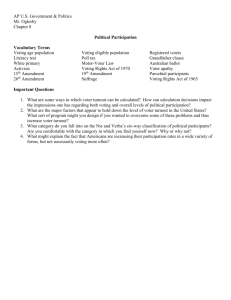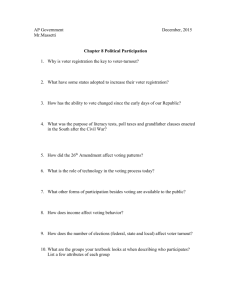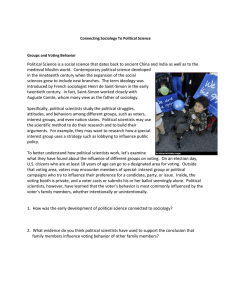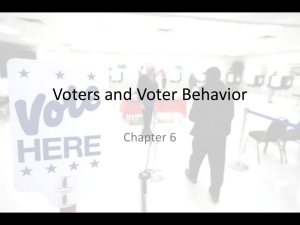CALTECH/MIT VOTING TECHNOLOGY PROJECT
advertisement
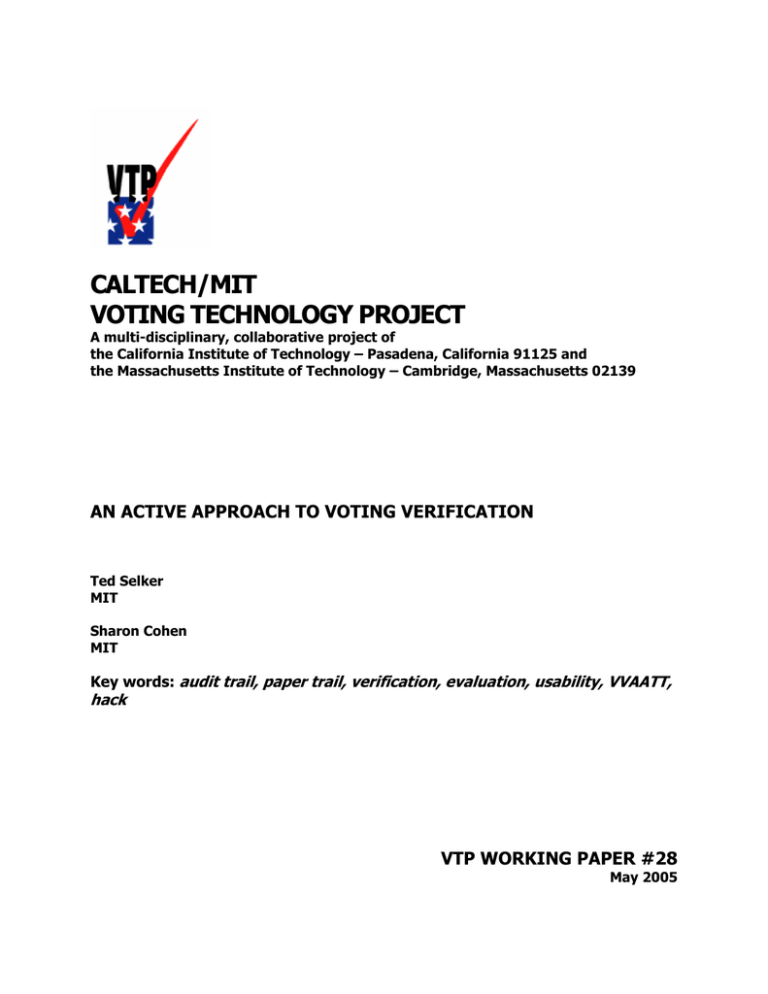
CALTECH/MIT VOTING TECHNOLOGY PROJECT A multi-disciplinary, collaborative project of the California Institute of Technology – Pasadena, California 91125 and the Massachusetts Institute of Technology – Cambridge, Massachusetts 02139 AN ACTIVE APPROACH TO VOTING VERIFICATION Ted Selker MIT Sharon Cohen MIT Key words: audit trail, paper trail, verification, evaluation, usability, VVAATT, hack VTP WORKING PAPER #28 May 2005 An Active Approach to Voting Verification Abstract. As our voting systems have come to rely more deeply on computer technology there have been great opportunities to improve the voting process, however, recently computer scientists and the general public have become wary of the amount of trust we place in the computers running our elections. Many proposals for audit systems to monitor our elections have been created. One popular audit system is the voter verified paper audit trail (VVPAT). Another more recent proposal is the voter verified audio audit transcript trail (VVAATT). In order to compare these two systems we conducted a user study where we purposely added errors to the audit trail in order to see if voters would be able to find these errors. Our results showed that voters found many more errors using the VVAATT system than they did with the VVPAT system. 1 Introduction In the past five years, following the 2000 Florida election fiasco, the voting technologies used in the United States have undergone a significant amount of change. The use of direct recording electronic (DRE) voting machines has increased significantly and provided great opportunities for advances in voting user interface design. However, as the use of DRE machines has spread, so too have concerns about the safety and security of the machines. Many people now believe that the machines should have an audit trail that does not rely on the electronic records of the votes stored in the DRE. One popular audit trail proposal is for the voter verified paper audit trail (VVPAT). The VVPAT system places a printer on the DRE machine and adds an extra step to the end of the voting process when the voter prints out and approves a paper receipt of their vote. A more recent proposal by Ted Selker introduces the idea of a voter verified audio audit transcript trail (VVAATT). A VVAATT system slightly modifies the voting interface, adding audio feedback to the voting process. The audio feedback is recorded and the recording serves as an audit for the election. When comparing the two audit systems, we designed our study to assess some of the most important factors to voting and audit systems, general usability of the system, the time needed for voters to use the system, and the number of errors voters were able to catch in each audit trail. 2 Voter Verified Paper Audit Trail The concept of a voter verified paper audit trail (VVPAT) actually predates the current controversy over DRE security. Rebecca Mercuri first introduced the VVPAT in March 1992. [1] The idea behind VVPAT is quite simple: (1) The voter uses the DRE to record their choices. (2) When they are finished recording their choices, they press a button on the DRE and a printout appears behind a glass panel. (3) The voter must read over the printout to verify that their selections have been properly recorded on the paper. (4) If the voter accepts the printout then the paper is deposited in a secured ballot box. Otherwise, if the voter rejects the printout, they will have to begin voting again. Rejected paper ballots are not deposited in the ballot box. 3 Voter Verified Audio Audit Transcript Trail The voter verified audio audit transcript trail (VVAATT) is a new idea for an audit mechanism that fits more naturally into the voting process. Selker introduced VVAATT [2, 3] in 2004 as an alternative to the VVPAT process that many people had previously focused on. The procedure a voter uses when voting on a VVAATT system is as follows: (1) The voter steps into the voting booth and puts on the provided headphones. (2) The voter begins voting as normal. (3) Each time the voter makes a selection, he hears a confirmation in the headphones. For example, when the voter selects candidate A, the DRE will say “selected candidate A”. (4) As the voter is listening to the audio feedback, it is recorded on some physical medium such as an audio cassette. (5) At the end of the session the voter submits their ballot and leaves the voting booth. There are two important differences between the VVPAT and VVAATT systems. One important difference is the timing of the verification process. When using a VVPAT, all verification is delayed till the end of the voting process, however, with a VVAATT verification is done throughout the voting process. Eliminating this time delay means that the voter does not have to rely on their memory to properly verify their votes, in addition, accidental mistakes such as pressing the wrong candidate may be more immediately identified with the audio feedback. The other main difference between the two systems is that VVAATT provides a multimodal form of verification while VVPAT does not. The VVAATT audio verification complements the visual verification that the voter receives from the DRE. Instead of competing for the voter’s attention, the two forms of feedback actually combine to heighten the voter’s attention and create a more engaging voting process. 3 A Comparative Study In order to compare VVAATT to VVPAT we conducted a user study involving 36 paid subjects. When comparing the two systems, we focused our study on deter- mining how easy it was for voters to use each system, how long it took voters to use the systems, and how many errors users were able to find with each system. 3.1 Equipment and Procedure When conducting this study we created our own VVPAT and VVAATT systems instead of using a commercial DRE. Both DRE’s used the Low Error Voter Interface (LEVI). This interface provides a significant amount of feedback to the voter and in another user study it was shown that errors were reduced when voters used LEVI as compared to some of the commercial DRE interfaces. The VVPAT system was implemented with a regular commercial receipt printer which we made a special enclosure for to insure that voters could not touch or handle the paper. The VVAATT system was implemented with the LEVI interface and a prototype VVAATT recording unit consisting of a tape recorder, and headphones. Each subject voted on both the VVPAT and the VVAATT systems. They completed 4 elections on each system. Each election consisted of 11 races with a mixture of single selection races and multiple selection races. For each election, we gave the subjects directions on how they should vote. Some races we simply told them who to vote for while other races we gave the subject an option of who to vote for. In addition on a few races, we instructed the subject to skip the race and make no selection. In order to collect data on how many errors the subjects were able to find, we purposely inserted errors in the audit trails. Each subject voted three elections which contained an error and one election which had no error. The three kinds of errors that we inserted in the audit trail were replacing the candidate the voter voted for with a different candidate, removing a vote for a candidate the voter had voted for, and removing a whole race from the audit trail. In all cases, the visual feedback that appeared on the screen and in the final review screen of the DRE was accurate, only the audit trail, either the paper receipt or the audio feedback was inaccurate. We took care to randomize the order of the errors that the voter received, the location of the no error election, and the system that the voter used first. 3.2 Results The initial results from our study reveal significant promise for the VVAATT system while also exposing some flaws with the VVPAT system. The most startling results from our study concerned the number of errors that voters were able to identify. We used three different measures of the errors found. The first measure was the number of errors that voters reported to us as they were voting. The second measure is the number of errors that we were able to observe voters reacting to even though they might not have reported the error to us. Finally, in our post-survey data, we asked voters to agree or disagree with the statements “there were some errors in the audio verification” and “there were some errors in the paper trail.” The numbers at each level are quite startling. Out of 108 elections that contained errors, 14 errors were reported to us in the VVAATT audit while no errors were reported in the VVPAT audit. 25 errors were recognized while using the VVAATT system as compared to only 3 while using the VVPAT system. Finally, in our post-survey data 85 percent of participants agreed with the statement that there were errors in the audio verification while only 8 percent agreed with this statement for the paper trail and over 60 percent of participants indicated that they were not sure if the paper trail contained errors. Almost a third of participants actually disagreed with the statement about errors in the paper trail. Two areas where the VVAATT did not fare as well as VVPAT were in regards to time required to use the system and general satisfaction with the system. In order for the audio feedback to serve as an audit record of the election, it can not be clipped while it is playing. This adds a delay to the general running of the system. We found that the VVAATT system required about a third more time than the VVPAT system. In regards to general satisfaction with the systems, while subjects found their experience voting on each system equally easy and enjoyable, the vast majority, over 90 percent said that they would recommend the VVPAT system to their county election commission. We believe that this preference is a result of voters’ familiarity with paper records in other situations and inexperience with audio records. 4 Conclusion The need for accurate and useable audit trail systems on our DRE voting machines is becoming more and more important as the technology becomes more widespread. Both VVPAT and VVAATT offer reliable and secure audit technology so evaluating which is preferable must be based on how voters are able to interact with the two systems. We designed our user study to put the audit systems to the test by inserting errors in the audit trail and observing how many errors voters were able to spot. In addition, we evaluated the systems on how long voters took to vote and voters’ general usability experience with each one. Our studies indicated that VVAATT serves as a much more accurate a useful audit trail with voters able to identify significantly more errors, however, it does take longer to vote and voters are less familiar and comfortable with an audio record. 5 Reference 1. R. Mercuri. "Physical Verifiability of Computer Systems," 5th International Computer Virus and Security Conference, March, 1992. 2. T. Selker. (September 2004). “The Voter Verified Audio Audit Transcript Trail (VVAATT)” [WWW Document] URL http://www.vote.caltech.edu/Reports/vtp_wp18.pdf, (visited 2004, December 6). 3. T. Selker. “Fixing the Vote,” Scientific American, October 2004.



